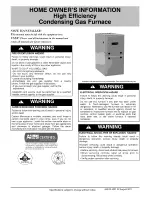
F97CMN and G97CMN: Installation, Start-up, Operating and Service and Maintenance Instructions
Manufacturer reserves the right to change, at any time, specifications and designs without notice and without obligations.
20
Roll-Out Protection
Provide a minimum 12-in. x 22-in. (305 x 559 mm) piece of sheet metal
for flame roll-out protection in front of burner area for furnaces closer
than 12-in. (305 mm) above the combustible deck or suspended furnaces
closer than 12-in. (305 mm) to joists. The sheet metal MUST extend
underneath the furnace casing by 1-in. (25 mm) with the door removed.
The bottom closure panel on furnaces of widths 17-1/2-in. (445 mm) and
larger may be used for flame roll-out protection when bottom of furnace
is used for return air connection. See
roll-out shield.
AIR DUCTS
General Requirements
The duct system should be designed and sized according to accepted
national standards such as those published by: Air Conditioning
Contractors Association (ACCA Manual D) , Sheet Metal and Air
Conditioning Contractors National Association (SMACNA) or
American Society of Heating, Refrigerating and Air Conditioning
Engineers (ASHRAE) or consult
The Air Systems Design Guidelines
reference tables available from your local distributor. The duct system
should be sized to handle the required system design CFM at the design
external static pressure. The furnace airflow rates are provided in
-Air Delivery-CFM (With Filter). When a furnace is installed so
that the supply ducts carry air circulated by the furnace to areas outside
the space containing the furnace, the return air shall also be handled by
duct(s) sealed to the furnace casing and terminating outside the space
containing the furnace.
Secure ductwork with proper fasteners for type of ductwork used. Seal
supply- and return-duct connections to furnace with code approved tape
or duct sealer.
NOTE:
Flexible connections should be used between ductwork and
furnace to prevent transmission of vibration.
Ductwork passing through unconditioned space should be insulated to
enhance system performance. When air conditioning is used, a vapor
barrier is recommended.
Maintain a 1-in. (25 mm) clearance from combustible materials to
supply air ductwork for a distance of 36-in. (914 mm) horizontally from
the furnace. See NFPA 90B or local code for further requirements.
Return Duct Sizing
Refer to the Filter Selection and Duct Sizing section for information on
the proper selection of filter sizes and the associated ductwork and duct
transitions. Improperly designed filtering systems and return ductwork
are the most common causes of airflow and/or noise complaints in
HVAC systems.
Ductwork Acoustical Treatment
NOTE:
Metal duct systems that do not have a 90 degree elbow and 10
ft. (3 M) of main duct to the first branch take-off may require internal
acoustical lining. As an alternative, fibrous ductwork may be used if
constructed and installed in accordance with the latest edition of
SMACNA construction standard on fibrous glass ducts. Both acoustical
lining and fibrous ductwork shall comply with NFPA 90B as tested by
UL Standard 181 for Class 1 Rigid air ducts.
NOTE:
For horizontal applications, the top most flange may be bent
past 90
?
to allow the evaporator coil to hang on the flange temporarily
while the remaining attachment and sealing of the coil are performed.
NOTICE
!
Many states, provinces and localities are considering or have
implemented standards and/or restrictions on duct sizing practices,
ductwork leakage, and/or ductwork thermal, airflow and electrical
efficiencies. CONSULT LOCAL CODE OFFICIALS for ductwork
design and performance requirements in your area.
















































